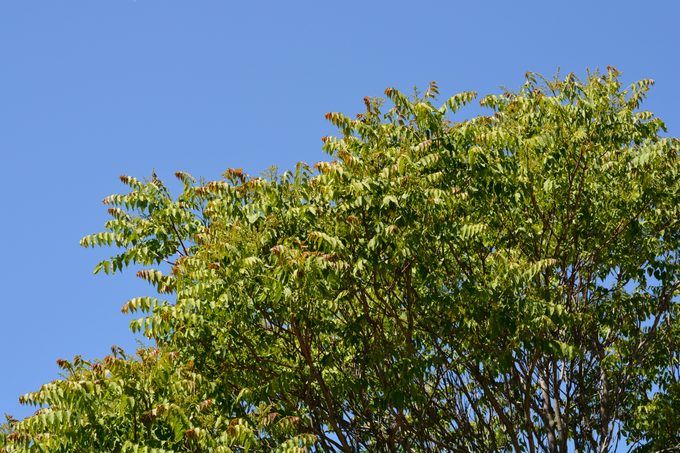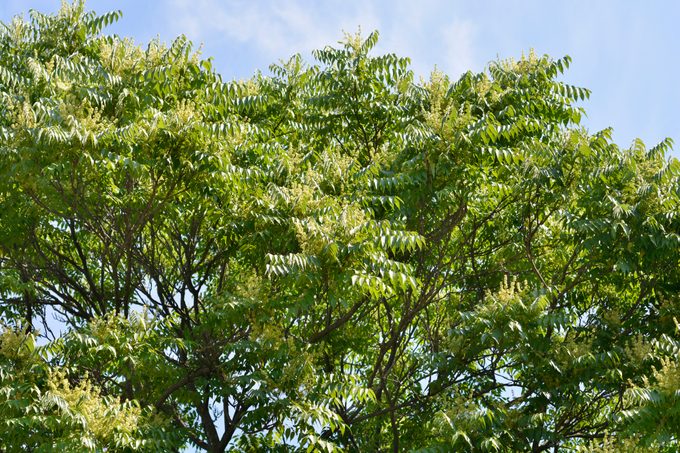Tree of heaven is highly invasive and incredibly difficult to eradicate. Learn how to control ailanthus and manage its unchecked spread.

Never Grow Devilishly Invasive Tree of Heaven (Ailanthus)

When early gardeners first brought tree of heaven to the United States, the country itself was less than a decade old. In the hundreds of years since, this ornamental tree has spread itself far and wide, turning into an unbelievable nuisance. Here’s what to know about controlling and managing tree of heaven in your own backyard.
On This Page
How to Identify Tree of Heaven

Ailanthus altissima is more commonly known as tree of heaven, Chinese sumac, stink tree, and often just ailanthus. It’s an ornamental tree that has a long history of importance in its native Taiwan and central China, where it’s traditionally used in folk medicine. (Interestingly, modern researchers are exploring the tree’s use in fighting cancer, malaria, and HIV.)
This tree grows very fast, reaching heights of up to 80 feet and trunks of 6 feet in diameter. The smooth, brownish-green bark of young trees turns rougher as it ages, eventually resembling a cantaloupe’s skin. The compound leaves can grow up to 4 feet long, made up of many lance-shaped leaflets. The leaves and bark give off a foul odor when crushed. The tree produces thousands of yellowish winged seeds that may stay on the tree throughout winter.
Why Is Tree of Heaven So Invasive?
“Tree of heaven is capable of producing hundreds of thousands of seeds per tree,” says Brian Walsh, a Penn State Extension Educator. This is bad enough—but it’s also just the start.
“This tree has the ability to reproduce via clonal roots,” Brian continues. “It’s allelopathic, which means it’s toxic to many other plants. Plus, it has the ability to thrive in sites that are highly disturbed and basically unfit for many of our native plants (such as sidewalk cracks).”
Essentially, tree of heaven is capable of thriving just about anywhere, and outcompeting the native plants it displaces. Once it gets started, it’s nearly impossible to get rid of. The sale of this tree is now prohibited in many places in the United States. If you do happen to come across it, horticulturalists recommend keeping it as far away from your own backyard as possible.
Is Tree of Heaven Invasive Everywhere in the U.S.?

The tree first came to the U.S. as a fast-growing ornamental, introduced to Pennsylvania in 1784 and to New York in 1820. During the gold rush of the mid-1800s, Chinese immigrants brought the tree to California as they came seeking better opportunities.
Today, the U.S. National Forest service notes this species is distributed from British Columbia, southern Ontario and Quebec, and Maine south to Florida, Texas, southern California, and Mexico. It’s considered most invasive from New England south to the mid-Atlantic states and throughout California. However, tree of heaven can be a serious problem wherever it’s found.
Host Plant for Invasive Spotted Lanternfly

Spotted lanternfly has become a serious concern to horticulturists in the United States, and it has a direct link to this tricky tree. In their native regions, spotted lanternfly and tree of heaven coexist, with the insect helping to keep the tree populations in check.
“Tree of heaven is a preferred host plant for spotted lanternfly,” Brian explains. In all life stages, these invasive insects use their piercing and sucking mouthparts to pierce plants and drink the sap. In fact, Brian says a serious infestation is actually capable of killing tree of heaven.
Unfortunately, outside of its native habitats, the spotted lanternfly is wreaking havoc in agricultural settings. “The only other plant that we have observed with such a consistently strong relationship with spotted lanternfly is grape, both wild and domestic. That’s why this insect is a significant threat to agriculture.” That gives responsible gardeners one more reason to do their best to control tree of heaven.
Is It Possible to Kill Tree of Heaven Completely?
At this point, you might be wondering how you can get rid of these invasive plants once and for all, eradicating them from your backyard. But as it turns out, that may not be the right mindset for tree of heaven.
“It can reinfest an area from clonal roots underground if they are not completely killed by herbicide,” Brian cautions. “It can resprout from seeds that have built up in the soil, and the seeds can wash or blow in from other areas. You might be able to eradicate it in a very localized area, such as on a given property or in a small park. But eradication implies that it won’t come back, and that is rarely, if ever, seen with tree of heaven.”
So, if you can’t eradicate it, what can you do? Brian explains that with the right methods, you can learn to control and manage this persistent tree instead. It’s not as simple as just chopping it down, though (that can actually make things worse). To control tree of heaven, you’ll need a plan of attack.
How to Control Tree of Heaven
To start, it’s important to understand that you’ll need a combination of methods, used at the right time. “Herbicide, applied at the right time of the year with methodology appropriate to the size of the plants, makes all the difference in successfully controlling tree of heaven — or just making it angry,” Brian stresses.
For help in learning how to get this invasive tree under control, Brian points to advice from his colleague, Emily Rojik, an invasive plant/forest specialist who has written in great detail about dealing with the tree.
“This species can only be effectively controlled with herbicide application,” she and Brian wrote in an April 2025 paper. “Note that the more commonly used cut-stump treatment (i.e., cutting the tree down and applying herbicide to the stump) is not recommended.”
Tree of Heaven Control Methods
There are three recommended methods for managing and controlling tree of heaven, and each has its own special set of instructions. Here’s an overview:
-
Basal Bark Application: This is used for trees with trunks of less than 6 inches in diameter, and applied from the ground up to about 18 inches on the trunk.
-
Hack and Squirt Application: Concentrated herbicides are applied in downward angled cuts spaced evenly around the trunk.
-
Foliar Application: This widespread application can be used when tree of heaven infests large areas, and surrounding vegetation won’t be damaged by the herbicides.
Get complete instructions on controlling and managing tree of heaven from Penn State Extension.
Herbicide Application Timing
In order to truly manage this invasive tree and potentially eliminate it, herbicides must be able to reach all the way down into the roots. Otherwise, it will merely spring back with hundreds of new shoots and root suckers.
“Target the roots with systemic herbicides applied in mid- to late summer (July to onset of fall color) when the tree is moving carbohydrates to the roots,” Brian and Emily wrote. “Herbicide applications made outside this late growing season window will only injure above ground growth. Following treatment, repeated site monitoring for signs of regrowth is critical to prevent re-infestation.”
Replace With Native Trees

It’s always best to replace invasive species with native alternatives, which will vary based on where you live. In east, try one of the native sumacs (like staghorn sumac or winged sumac) or scarlet buckeye. Out west, consider sycamore or western redbud instead.
Sources
- Penn State Extension – “Tree of Heaven”
- Rhode Island Wild Plant Society – “Look-alikes: Tree of Heaven”
- Mississippi Forestry Commission – “Tree of Heaven”
- University of California Agriculture and Natural Resources – “Say No to Invasive Plants and Garden for a Greener California”
- USDA Forest Service Fire Effects Information System – “Ailanthus altissima”
About the Experts
Brian Walsh and Emily Rojik work as Penn State Extension educators. Brian specializes in spotted lanternfly research, pesticide application, and commercial horticulture. Emily’s work focuses on herbicides, invasive plant management, and forest management.




















